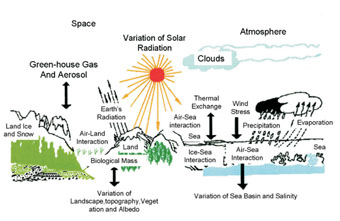After four-year hard work, a research project on the formation mechanism and prediction theory of severe climatic disasters in China has met all its phase targets and achieved important advances, says Prof. Huan Ronghui, a CAS member with the CAS Institute of Atmospheric Physics and principal investigator of the project.
The research, which is hosted by CAS, is part of a project financed by the National Key Program for Developing Basic Sciences to address both climate and synoptic calamities. It is also a key part of China' s participation in an international research program on climate variability and predictability called CLIVAR.
Researchers started the project by examining the occurrence of severe climatic disasters such as droughts and floods in China. They then proposed the formation mechanism of such disasters on the basis of profound analysis of the interactions among various spheres of the climate system, especially the interactions among the various components of the East Asian climate system. They also designed a corresponding numerical climate model, thereby presenting an extra-seasonal and annual prediction theory for severe climatic disasters in China. Moreover, in order to reveal the formation mechanism of climatic disasters and to obtain more exact physical parameters in numerical models, the researchers also engaged in macro-scale observational studies.
Under the guidance of six CAS members and through arduous efforts over the past three years, the research team, consisting of over 70 scholars from CAS, universities and colleges under the Ministry of Education, the National Meteorological Administration and the State Oceanic Administration, has made great progress. The project first made in-depth analyses of the formation mechanism of severe climatic disasters and put forward new theories on "the East Asian climate system," "interactions between the East Asian monsoon, the Pacific warm pool and the ENSO cycle (el Ni and la Ni events in the tropical Pacific)" and "the atmospheric adaptation over the Tibetan Plateau" associated with the formation mechanism of severe climatic disasters in China. Moreover, this project also made new discoveries on the mechanism of the ENSO cycle and its numerical model, greatly increasing the prediction level of ENSO-related effects in China. Based on the above-mentioned theoretical studies, a numerical prediction model of extraseasonal climate anomalies in China was proposed and the severe droughts and floods in China during the period 1998--2001 were successfully predicted. In addition, the project successfully carried out the "Observational Experiment on the Air-Land Interaction in the Arid Regions of Northwest China," which provided much valuable data associated with air-land interaction in the typical arid regions of northwest China. This may provide reliable climatic and environmental data for the development of northwest China.
It is urgently necessary to undertake research on the formation and prediction of severe climatic disasters in China, including the prediction of seasonal and annual climate anomalies. China is located in the East Asian monsoon region. Since the East Asian monsoon varies greatly in both strength and duration, climatic disasters occur frequently in China. Especially since the 1980s, calamities such as droughts and floods over large areas have wrought ruinous damage to China' s agricultural and industrial production. The economic losses due to drought and flood can reach over 200 billion yuan (US$ 24 billion), accounting for 3--6% of China' s GDP. In the summer of 1998, for example, the exceptionally calamitous floods along the Yangtze, Songhua and Nen rivers valley caused losses as high as 260 billion yuan (US$ 31 billion). In addition, the severe droughts in north China in 1999 and 2000 not only wreaked havoc on agriculture and industry, but also seriously affected the water resources and ecological environment in this region and caused a great increase in the frequency of dust and sand-storms.

A schematic map for climate system.







